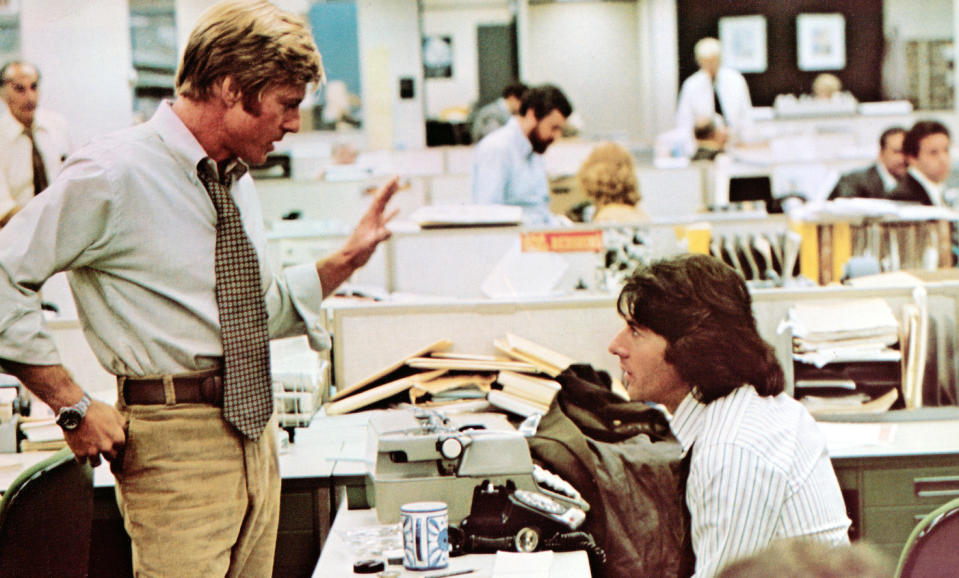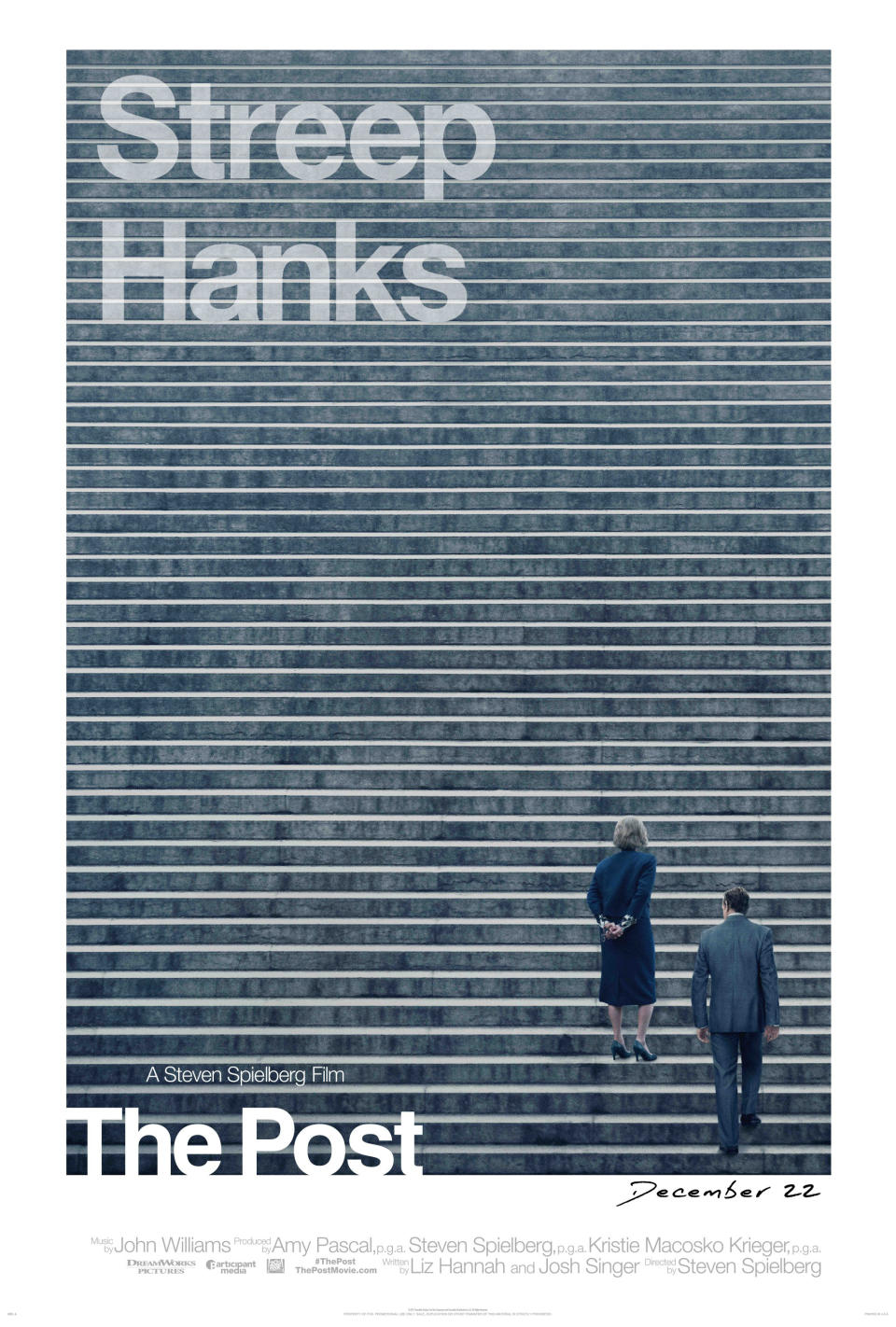5 things we learned about 'The Post' from Spielberg, Streep, and Hanks

Set in 1971, Steven Spielberg’s 30th directorial effort, The Post, dramatizes the efforts of Washington Post editor Ben Bradlee (Tom Hanks) and owner Katharine “Kay” Graham (Meryl Streep) to publish the Pentagon Papers over the strenuous objections of the Richard Nixon administration. Although the events in the film took place four decades ago, its contemporary relevance wasn’t lost on anyone in the audience for its first public unveiling last night in New York City. Sitting alongside his stars — as well as costume designer Ann Roth and supporting players Bob Odenkirk and Matthew Rhys (who play Post reporter Ben Bagdikian and iconic whistleblower Daniel Ellsberg, respectively) — for a post-screening Q&A, Spielberg declined to draw overt parallels between White House occupants past and present and their troubled relationship with the nation’s free press.
At the same time, he did make it clear that he very much had today’s headlines on the brain while making The Post, which opens in theaters on Dec. 22. “The relevance is up to everyone to strike their own balance between the news today and the news then,” the director remarked. “Obviously, sometimes bad things happen twice. And history certainly is repeating itself.” Here are five things we learned from the half-hour-long conversation with the cast and crew of The Post.
Time was of the essence
Spielberg was deep in the process of completing his upcoming, effects-heavy blockbuster Ready Player One when he first received an early draft of the script of The Post, penned by Liz Hannah. Rather than place it on his to-be-read pile, he dived in right away and then met with its author, coming away from that conversation convinced that it was a movie he had to make — and soon. So while the effects wizards at Industrial Light & Magic finished up the elaborate digital effects required for Ready Player One, Spielberg moved at light speed to get The Post into production, assembling his longtime creative team (including regular cinematographer Janusz Kaminski and composer John Williams) while Oscar-winning Spotlight co-writer Josh Singer did a polish on the screenplay. “I read the script in February, we started shooting on the first of May, and we were done by the third week of July,” Hanks said of the production’s rapid pace. And Spielberg emphasized that he didn’t want anything to delay his ability to deliver The Post to theaters by the end of 2017. “This was something that couldn’t wait for two or three years — this was a story I thought we needed to tell today.”
Hanks had a personal history with the real Bradlee and Graham
Both of the film’s principal subjects passed away well before the film went into production; Graham died in 2001, and Bradlee followed in 2014. Unaware that he’d one day be telling their story on the big screen, Hanks spent time with each of them — in Graham’s case, on the very day she passed away. “She was at a conference in Idaho, and we had lunch together with a bunch of other people,” the actor said. “We said, ‘So long,’ and she drove off in her golf cart. I think she passed away within the next 12 hours.” (Costume designer Ann Roth, meanwhile, shared an amusing Graham anecdote: “I once designed her Halloween costume! Mike Nichols roped me into it. I had a great time.”) Hanks enjoyed a lengthier relationship with Bradlee, whom he spent time with before the editor was diagnosed with dementia in his later years. “Ben Bradlee loved Kay Graham. He loved her deeply with a love that came from a deep, deep respect and understanding of all that she had been through and all that she accomplished.”

All the President’s Men wasn’t part of Spielberg’s research
Alan J. Pakula’s 1976 classic remains the gold standard when it comes to movies about Watergate, as well as movies about journalism. And that’s precisely why Spielberg — who calls it a “great film” — avoided referencing it in The Post, even in the very design of the Washington Post‘s offices. “I was concerned about using the same colorful set as All the President’s Men,” he explained. “Then I found out that because of the success of the Pentagon Papers [story], they actually moved into entirely different buildings! Rick Carter [the film’s production designer] went back and found pictures of the Washington Post in the ’60s and early ’70s, and that’s exactly what he created.” While Spielberg may have consciously been avoiding homages to that particular ’70s favorite, Odenkirk, for one, caught him re-creating that decade in some of their scenes together. After one sequence where Bagdikian has to make an important call on a pay phone, the Better Call Saul star said that “[Steven] came right up to me and went, ‘It’s like a ’70s movie!’”
Here’s what you won’t see
The saga of how Ellsberg leaked the Pentagon Papers to the press is the stuff that great thrillers are made of. And there were several “strange but true” moments that Spielberg felt he had to leave out of The Post, lest audiences accuse him of making things up. Case in point: Ellsberg apparently involved his 8-year-old daughter in his whistleblowing activities. “He had to copy 40 volumes; it took him months and months,” Spielberg said. “A couple of times he needed help, and he got his kids to come with him. His daughter was bored, and he said, ‘Look, take a scissors and cut off everything that says ‘Top Secret’ and the page numbers at the bottom of these documents.’ And she sat there and cut all of these documents at 8 years old!’” Spielberg also toyed with making Nixon a more prominent character in the film before ultimately deciding that the former president’s “performance” would mostly consist of archival recordings of his Oval Office tapes. “It was more important to us to show these explorers trying to get to the truth and get it out there for all of us to read. There were times when we flirted with going more into the White House, but they had already made the Nixon movie, and I wasn’t interested in doing Nixon 2.”

Who’s the boss
While politics and censorship take center stage in The Post, the film is also an equally timely depiction of a woman in a position of power who is nevertheless treated as a subordinate by the men in her industry. Spielberg emphasized that that theme was very much present in the script that Liz Hannah wrote, long before the dam burst on the stories of harassment and misogyny currently pouring out of Washington, D.C., and Hollywood. “That was a major contribution to the movie that exists today, and really made us look at the fact that decades could not erase what is continuing to occur today.” For her part, Streep relished depicting how Graham finds her voice in the course of the film, and how her unique relationship with Bradlee played a role in that. “It’s a relationship between a man and a woman that wasn’t based on any kind of other feelings,” the actress — who seems poised to score her 21st Oscar nomination — explained. “That interested me, because it was about the working atmosphere, and that’s so important to think about right now. The atmosphere in which men and women can deal with each other, especially if the woman is the superior. To watch them evolve through the course of this challenge that’s put to the two of them together — his bravado and her bravery, those two things are just kind of gorgeous [to watch].”
The Post opens in theaters on Dec. 22.
Watch the trailer:
Read more from Yahoo Entertainment:


